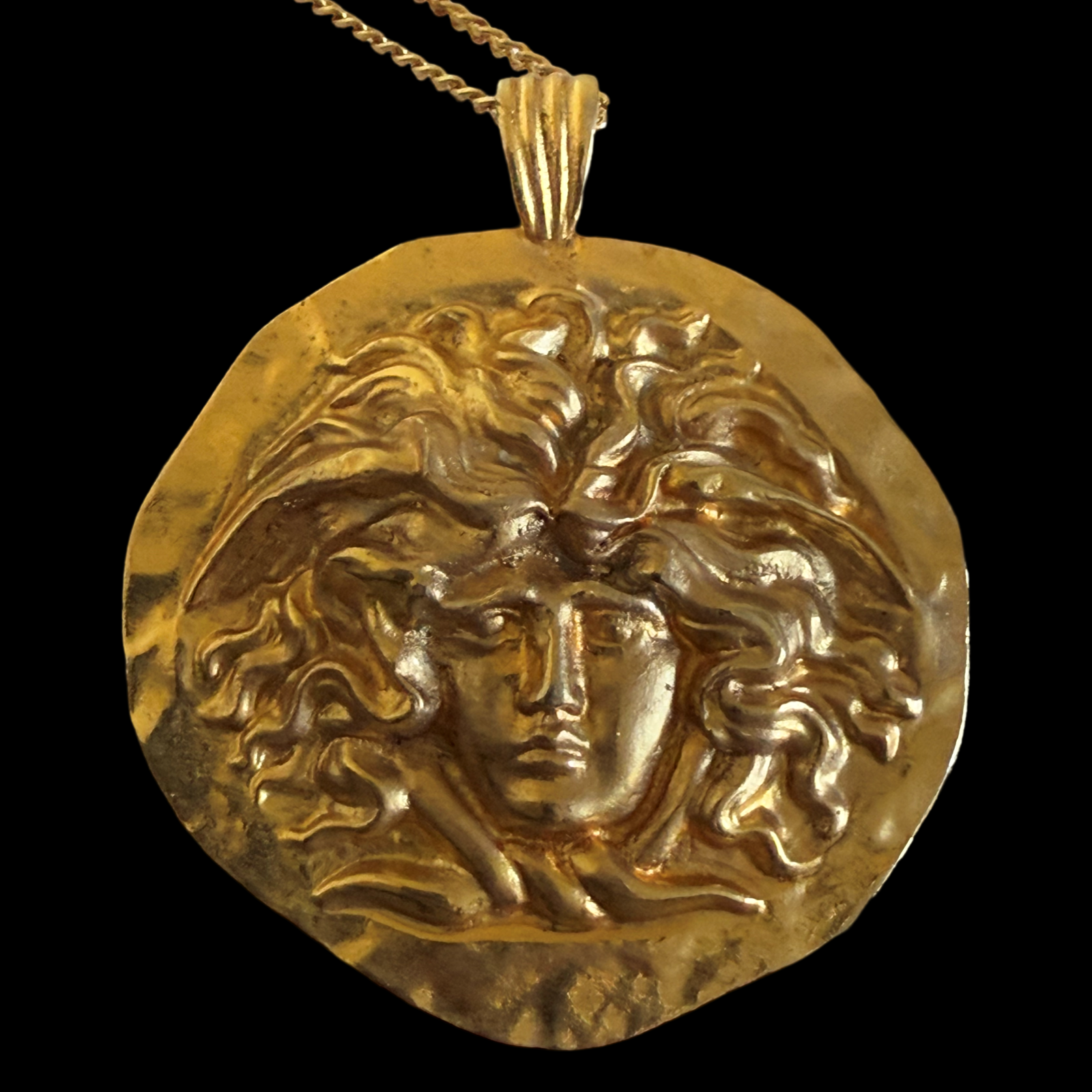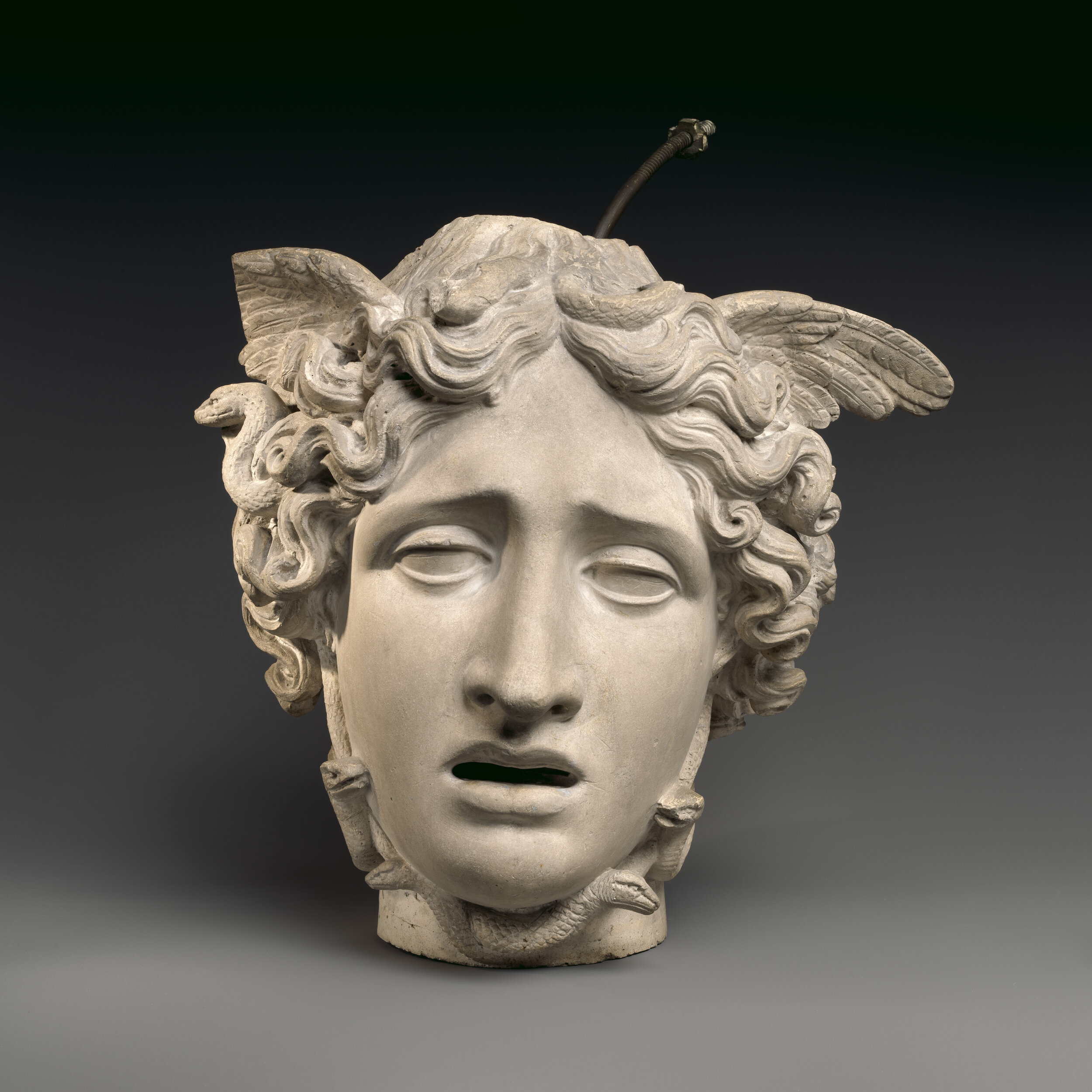The Gorgoneion, Head of the Gorgon
In Greek mythology, the Gorgons were a trio of monster sisters — Stheno, Euryale and Medusa. Medusa, the only mortal sister of the three, was a radiant maiden, admired by many. Yet, her beauty became her curse.
When she and Poseidon gave in to a forbidden love in the sacred temple of Athena, the goddess’s wrath was swift. Athena, in her fury, transformed Medusa's luscious locks into a tangle of venomous snakes. One glimpse of her hideous visage would turn a man to stone.
The Gorgons retreated to a faraway island, where they lived in unholy solitude, doing whatever Gorgons do until fate led Perseus into their path. The hero, tasked with a mission, met the sisters with a sharp resolve and decapitated Medusa, her severed head a weapon of both doom and salvation. With it, Perseus defeated King Polydectes — the very man who had sought to claim his mother, Danae, as his own.
(As an aside, in the 1981 cult classic film The Clash of the Titans (and the 2010 remake), the tale takes a twist — Perseus uses Medusa’s head to turn the mythical Kraken to stone, saving the kingdom of Argos from certain annihilation. While the Kraken is a beast of Norse legend, its cinematic clash with Medusa’s power weaves a rich narrative. The severed head, flung into the sea, gave rise to the ancient Roman belief that red coral is the hardened blood of Medusa herself.)
Now back to the business at hand…
According to Elworthy’s The Evil Eye, “…Perseus presented the terrible head to Pallas, the Athenian goddess, who placed it on her aegis, and in nearly all her statues, and those of her Roman counterpart Minerva (Athena), she bears this notable mask as an amulet. Originally the aegis was a goat’s hide worn as a protective garment, but later it became a breastplate and afterwards a shield. When Minerva is represented with a shield as the war goddess, she has the gorgon’s head emblazoned upon it. Thus was first set the fashion of bearing some prophylactic device by men in battle which should first attract the angry glance of their enemies and then baffle their malignity.”
And so we learn that the visage of the Gorgon, or Gorgoneion, was applied to coins, artwork and buildings in the ancient world as an apotropaic motif. Earlier depictions of the Gorgon’s countenance were quite hideous, typically featuring a tongue protruding from a fanged grimace. But over time Medusa acquired more classically attractive features and a somewhat tragic expression. (See, for example, the cameos below.) Today, Medusa is a feminist symbol of women’s power. The gorgoneion is worn as a protective pendant and has been immortalized in the logo of Italian fashion house Versace.
Terracotta antefix (roof tile), 6th century B.C. Metropolitan Museum of Art.
Gorgon Head antefix, The J. Paul Getty Museum.
Coin of Populonia with the Head of a Gorgon, Museum of Fine Arts Boston

Running Gorgon c. 540 BC. Bronze. Yale University Art Museums
Gold pendant in the form of the Gorgoneion. Metropolitan Museum of Art.
Bronze ornament from a chariot pole 1st–2nd century A.D. Metropolitan Museum of Art.

Hand Mirror decorated with the head of Medusa, The J. Paul Getty Museum
Head of Medusa cameo 1840–50, Cameo by Benedetto Pistrucci. Metropolitan Museum of Art.
Head of Medusa, Arnold Böcklin. Museum of Fine Arts Boston.
Oval gem with the head of Medusa and inscription, 2nd or 3rd century AD, Museum of Fine Arts Boston.
Inscription reads: "If they talk, let them not be believed by Alexios! Chnoubis!"

Shell cameo depicting Medusa, late 19th century. Lightner Museum, St. Augustine, FL.

Perseus with the Head of Medusa, 1804–6 Antonio Canova Italian. Metropolitan Museum of Art.
Medusa ca. 1860–70, Luigi Saulini, Italy. Metropolitan Museum of Art.
Pallas Athena holding a shield with Medusa's head in her right hand and a lance in her left hand, Metropolitan Museum of Art
Terracotta two-handled vase, late 4th–early 3rd century B.C. Metropolitan Museum of Art.
Lidded vase with Medusa decoration and snake handles ca. 1891. Metropolitan Museum of Art.
Méduse 1600 / 1700 (XVIIe siècle [?]) Gian Lorenzo Bernini from the collection of The Louvre

Medusa Medallion by Sphinx BM; House of Good Fortune Collection,

















![Méduse 1600 / 1700 (XVIIe siècle [?])
Gian Lorenzo Bernini from the collection of The Louvre](https://images.squarespace-cdn.com/content/v1/5e8f0836b5232a64ef36347b/d6f6de61-b66d-4a97-a3a3-9f69dc53e0a7/0001188567_OG.JPG)